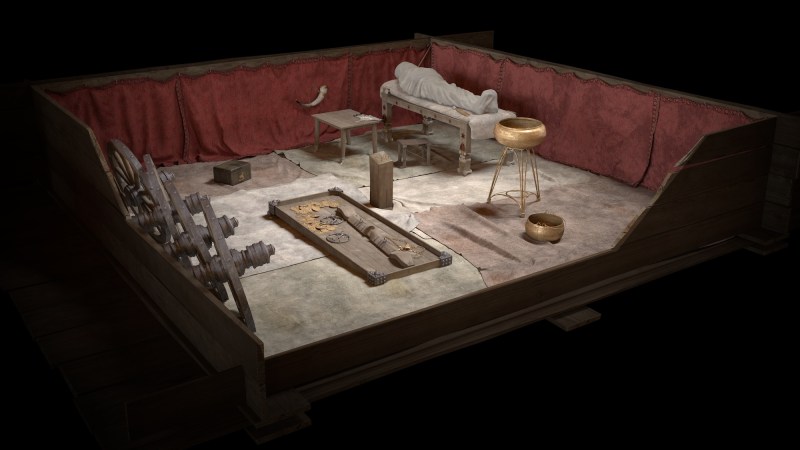

Building ancient Egypt’s famed pyramids was an enormous physical undertaking, but there was also a great deal of clerical and administrative work to be done by scribes. The repetitive tasks carried out by these high-status men and the positions that they sat in while working potentially led to degenerative changes in their skeletons. The bony findings are described in a study published June 27 in the journal Scientific Reports and provide a window into the lives of scribes during the third millennium BCE.
A time of pyramid builders and scribes
The scribes in this new study lived during ancient Egypt’s Old Kingdom (2700 to 2180 BCE). This is also the time of the pyramid builders and when the king was regarded as a living god. Some of the remains date back to the reign of King Nyuserre, who ruled for roughly 30 years.
“During his reign there were many changes in administration, religion and the architecture of non-royal tombs,” Veronika Dulíková, a study co-author and Egyptologist at Charles University’s Czech Institute of Egyptology, tells Popular Science. “It is during his reign that strategic royal policy is observed on a larger scale for the first time in ancient Egypt. He married princesses into the families of influential and powerful dignitaries in order to cement alliances with them.”
According to Dulíková, scientists and historians can gauge the social status of an individual by the location of the tomb within a cemetery, its dimensions, and the types of materials used in the burial. The scribes themselves were high status men who could write and perform administrative tasks.

“These were mainly texts of an administrative nature relating to the functioning of individual offices and the running of the country as a whole,” says Dulíková. “They were also texts related to the functioning of the royal pyramid complexes, i.e. the tombs of the kings. Since the ancient Egyptians recorded everything very carefully, we can learn from these texts which of the dignitaries in the role of priest (e.g. hem-netjer-priest) served the pyramid temple, which furniture and utensils were kept in the storerooms of such a temple, etc.”
Truth in bones
In the study, the team examined the skeletal remains of 69 adult males buried in the necropolis at Abusir, Egypt between 2700 and 2180 BCE. Thirty of these men were scribes. The team found that degenerative joint changes were more common among scribes, when compared to men who held other occupations. They saw these changes in the joints connecting the lower jaw to the skull, the right collarbone, the top of the right humerus where it meets the shoulder, the first metacarpal bone in the right thumb, the bottom of the thigh where it meets the knee, and throughout the spine, but particularly at the top.
[Related: Long-lost Nile branch may explain landlocked pyramids.]
“Contrary to our expectation, scribes differed minimally from other men in the degree of lower limb involvement. This is probably due to the fact that the cross-legged sitting or kneeling position was common and natural in the rest of the population,” Petra Brukner Havelková, a study co-author and anthropologist at the National Museum in Prague, tells Popular Science. “But perhaps the biggest surprise was the extreme overloading of the jaw joints in the scribes. This was something we hadn’t even hypothesized at first, focusing primarily on the rest of the skeleton outside the skull.”
They believe that the bone changes could be indicative of physical stress caused by repeated use in the humerus and left hip bone. These were more common among scribes than men from other professions. The scribe’s skeletons also showed an indentation on both kneecaps and a flattened surface on a bone in the lower part of the right ankle.
The degeneration seen in their spines and shoulders may come from sitting in a crossed-legged position with the head bent forward, spine flexed, and arms unsupported. Changes in the knees may indicate that scribes preferred to sit with their left leg in a kneeling or cross-legged position and the right leg bent with the knee pointing upwards, in a crouching or squatting position. Various statues and wall decorations in tombs have shown scribes sitting in both of these positions and also standing while working.
[Related: Ancient child’s grave holds intricate necklace with more than 2,000 stones.]
Jaw joint degeneration could have resulted from scribes chewing on the ends of rush stems to form brush-like heads that they could write with. Right thumb bone changes may have been caused by constantly pinching pens.
“When we got the results and put these changes in relation to the chewing of their thin brush-like pen made of rush, but also to the disability of the cervical spine, which is functionally closely related to the temporomandibular joint, it actually seems quite logical and expected,” says Havelková.
Math meets anthropology
According to Havelková and Dulíková, this is only the beginning of this type of research into the bones of scribes. They hope to confirm these hypotheses with additional studies, ideally on a different set of human skeletal remains from a similar time and place near this Old Kingdom burial site.
“I am very excited about the interdisciplinary collaboration with anthropologists and mathematicians,” says Dulíková. “Mathematicians have a different way of thinking, a different way of working and different questions. And so do the anthropologists. So our joint research on Old Kingdom society has great potential for new insights into its functioning.”















